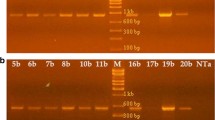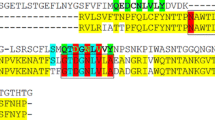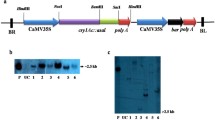Abstract
Lectins are important for plant defence against various insect and viral invasions. Allium species are rich source of lectins, but till date no lectin is reported to have insecticidal activity against the onion thrips. In the present study, wild Allium species were mined for potential lectins against onion thrips. The full-length lectin genes were amplified and cloned from four wild Allium species (A. hookeri, A. altaicum, A. fistulosum and A. angulosum) which is 534 bp in length. The ‘QXDXNXVXY’ motif responsible for recognition of alpha-D-mannose is present in all the sequences of lectin. The qPCR expression analysis of lectin genes showed that A. hookeri has fourfold more expression as compared to the onion (Allium cepa). The whole plant damage assay and detached leaf damage assay revealed that A. hookeri was resistant to Thrips tabaci. The per cent leaf area damage was lowest in A. hookeri, and further larval survival rate of T. tabaci was also least (61.46 ± 1.47%) when fed on A. hookeri. The overall development of T. tabaci was also found to be delayed on A. hookeri compared to other species. The present investigation will be helpful in developing interspecific crosses and transgenics for thrips control in onion.





Similar content being viewed by others
References
Lewis T (1997) Thrips as crop pests. CAB International, New York, NY
Diaz-Montano J, Fuchs M, Nault BA, Fail J, Shelton AM (2011) Onion thrips (Thysanoptera: Thripidae): a global pest of increasing concern in onion. J Econ Entomol 104:1–13. https://doi.org/10.1603/ec10269
Reitz SR (2009) Biology and ecology of the western flower thrips (Thysanoptera: Thripidae): the making of a pest. Florida Entomol 92(1):7–13. https://doi.org/10.1653/024.092.0102
Srinivas PS, Lawande KE (2004) Impact of planting dates on Thrips tabaci Lindeman infestation and yield loss in onion (Allium cepa L.). Pest Manag Horti Ecosys 10:11–18
Balan RK, Ramasamy A, Hande RH, Gawande SJ, Krishna Kumar NK (2018) Genome-wide identification, expression profiling, and target gene analysis of micro RNA s in the Onion thrips, Thrips tabaci Lindeman (Thysanoptera: Thripidae), vectors of tospoviruses (Bunyaviridae). Ecol Evol 8(13):6399–6419. https://doi.org/10.1002/ece3.3762
Liu TX (2004) Seasonal population dynamics, life stage composition of Thrips tabaci (Thysanoptera: Thripidae), and predaceous natural enemies on onions in south Texas. Southwest Entomol 29:127–135
Boulter D (1993) Insect pest control by copying nature using genetically engineered crops. Phytochemistry 34(6):1453–1466. https://doi.org/10.1016/s0031-9422(00)90828-8
Murdock LL, Shade RE (2002) Lectins and protease inhibitors as plant defenses against insects. J Agric Food Chem 50(22):6605–6611. https://doi.org/10.1021/jf020192c
Vandenborre G, Smagghe G, Van Damme EJ (2011) Plant lectins as defense proteins against phytophagous insects. Phytochemistry 72(13):1538–1550. https://doi.org/10.1016/j.phytochem.2011.02.024
Van Damme EJ, Peumans WJ, Barre A, Rougé P (1998) Plant lectins, a composite of several distinct families of structurally and evolutionary related proteins with diverse biological roles. Crit Rev Plant Sci 17:575–692. https://doi.org/10.1080/07352689891304276
Goławska S, Sprawka I, Lukasik I, Goławski A (2014) Are naringenin and quercetin useful chemicals in pest-management strategies? J Pest Sci 87(1):173–180. https://doi.org/10.1007/s10340-013-0535-5
Peumans WJ, Smeets K, Van Nerum K, Van Leuven F, Van Damme EJ (1997) Lectin and alliinase are the predominant proteins in nectar from leek (Allium porrum L.) flowers. Planta 201(3):298–302. https://doi.org/10.1007/s004250050070
Upadhyay SK, Saurabh S, Singh R, Rai P, Dubey NK, Chandrashekar K, Negi KS, Tuli R, Singh PK (2011) Purification and characterization of a lectin with high hemagglutination property isolated from Allium altaicum. Protein J 30(6):374–383. https://doi.org/10.1007/s10930-011-9342-0
Upadhyay SK, Singh PK (2012) Receptors of garlic (Allium sativum) lectins and their role in insecticidal action. Protein J 31(6):439–446. https://doi.org/10.1007/s10930-012-9423-8
Livak KJ, Schmittgen TD (2001) Analysis of relative gene expression data using real-time quantitative PCR and the 2 − ΔΔCT method. Methods 25(4):402–408. https://doi.org/10.1006/meth.2001.1262
Hiscox JD, Israelsta GF (1979) A method for the extraction of chlorophyll from leaf tissue without maceration. Can J Bot 57:1332–1334. https://doi.org/10.1139/B79-163
Benzie IF, Strain JJ (1996) The ferric reducing ability of plasma (FRAP) as a measure of “antioxidant power”: the FRAP assay. Anal Biochem 239(1):70–76. https://doi.org/10.1006/abio.1996.0292
Pinelo M, Rubilar M, Sineiro J, Nunez MJ (2004) Extraction of antioxidant phenolics from almond hulls (Prunus amygdalus) and pine sawdust (Pinus pinaster). Food Chem 85(2):267–273. https://doi.org/10.1016/j.foodchem.2003.06.020
Chandra S, Khan S, Avula B, Lata H, Yang MH, ElSohly MA, Khan IA (2014) Assessment of total phenolic and flavonoid content, antioxidant properties, and yield of aeroponically and conventionally grown leafy vegetables and fruit crops: a comparative study. Evid Based Complementary Altern Med 25:3875. https://doi.org/10.1155/2014/253875
Karuppaiah V, Soumia PS, Thangasamy A, Wagh PD, Dilipsundar N, Singh M (2019) Humid thermal ratio: an index to understand the population dynamics of thrips, Thrips tabaci Lindeman (Thysanoptera: Thripidae), in bulb onion. Afr Entomol 27(2):410–417. https://doi.org/10.4001/003.027.0410
Malone LA, Gatehouse AM, Barratt BI (2008) Beyond Bt: alternative strategies for insect-resistant genetically modified crops. Integration of insect-resistant genetically modified crops within IPM programs. Springer, Dordrecht, pp 357–417
Bakhsha A, Zia MAB, Hussain T, Tekeli FO, Gokce AF (2016) Members of Alliaceae; better source of plant lectins to combat resistance against sucking pests of crops. Acta Hort 1143:333–340
Ooi LS, Yu H, Chen CM, Sun SS, Ooi VE (2002) Isolation and characterization of a bioactive mannose-binding protein from the Chinese chive Allium tuberosum. J Agric Food Chem 50(4):696–700. https://doi.org/10.1021/jf010878p
Van Damme EJ, Smeets K, Torrekens S, Van Leuven F, Peumans WJ (1993) The mannose-specific lectins from ramsons (Allium ursinum L) are encoded by three sets of genes. Eur J Biochem 217(1):123–129. https://doi.org/10.1111/j.1432-1033.1993.tb18226.x
Ramachandraiah G, Chandra N (2000) Sequence and structural determinants of mannose recognition. Proteins 39(4):358–364
Afolabi-Balogun NB, Inuwa HM, Ishiyaku MF, Bakare-Odunoola MT, Nok AJ (2012) Isolation and characterization of a mannose-binding insecticidal lectin gene from Allium sativum (garlic) and its putative role in insect resistance using bioinformatics tools. Infect Genet Evol 12(7):1508–1512. https://doi.org/10.1016/j.meegid.2012.05.008
Jimenez HJ, Martins LSS, Carvalho R, Montarroyos AVV, Moraes Filho RM (2019) In silico characterization and phylogenetic analysis of a mannose-specific lectin in Allium species. Gen Mol Res 18(2):18187. https://doi.org/10.4238/gmr18187
War AR, Paulraj MG, Ahmad T, Buhroo AA, Hussain B, Ignacimuthu S, Sharma HC (2012) Mechanisms of plant defense against insect herbivores. Plant Signal Behav 7(10):1306–1320. https://doi.org/10.4161/psb.21663
Khandagale K, Krishna R, Roylawar P, Ade AB, Benke A, Shinde B, Singh M, Gawande SJ, Rai A (2020) Omics approaches in Allium research: progress and way ahead. Peer J 8:e9824. https://doi.org/10.7717/peerj.9824
Macedo ML, Oliveira CF, Oliveira CT (2015) Insecticidal activity of plant lectins and potential application in crop protection. Molecules 20(2):2014–2033. https://doi.org/10.3390/molecules20022014
Acknowledgements
The first author greatly acknowledges the Savitribai Phule Pune University for providing post-doctoral fellowship (SPPU-PDF/ST/BL/2018/0003).
Author information
Authors and Affiliations
Corresponding author
Ethics declarations
Conflict of interest
The authors declare that they have no conflict of interest.
Additional information
Publisher's Note
Springer Nature remains neutral with regard to jurisdictional claims in published maps and institutional affiliations.
Significance statement
The present article describes the importance of insecticidal lectins for plant defence against various insects. Wild Allium species are rich source of lectins, and potential entomotoxic lectin genes against onion thrips were studied. In future, this work helps in management of important onion pest: onion thrips.
Rights and permissions
About this article
Cite this article
Khandagale, K., Roylawar, P., Randive, P. et al. Isolation and Expression Profiling of Insecticidal Lectins from Wild Alliums Against Onion Thrips (Thrips tabaci Lindeman). Proc. Natl. Acad. Sci., India, Sect. B Biol. Sci. 92, 451–459 (2022). https://doi.org/10.1007/s40011-022-01360-4
Received:
Revised:
Accepted:
Published:
Issue Date:
DOI: https://doi.org/10.1007/s40011-022-01360-4




